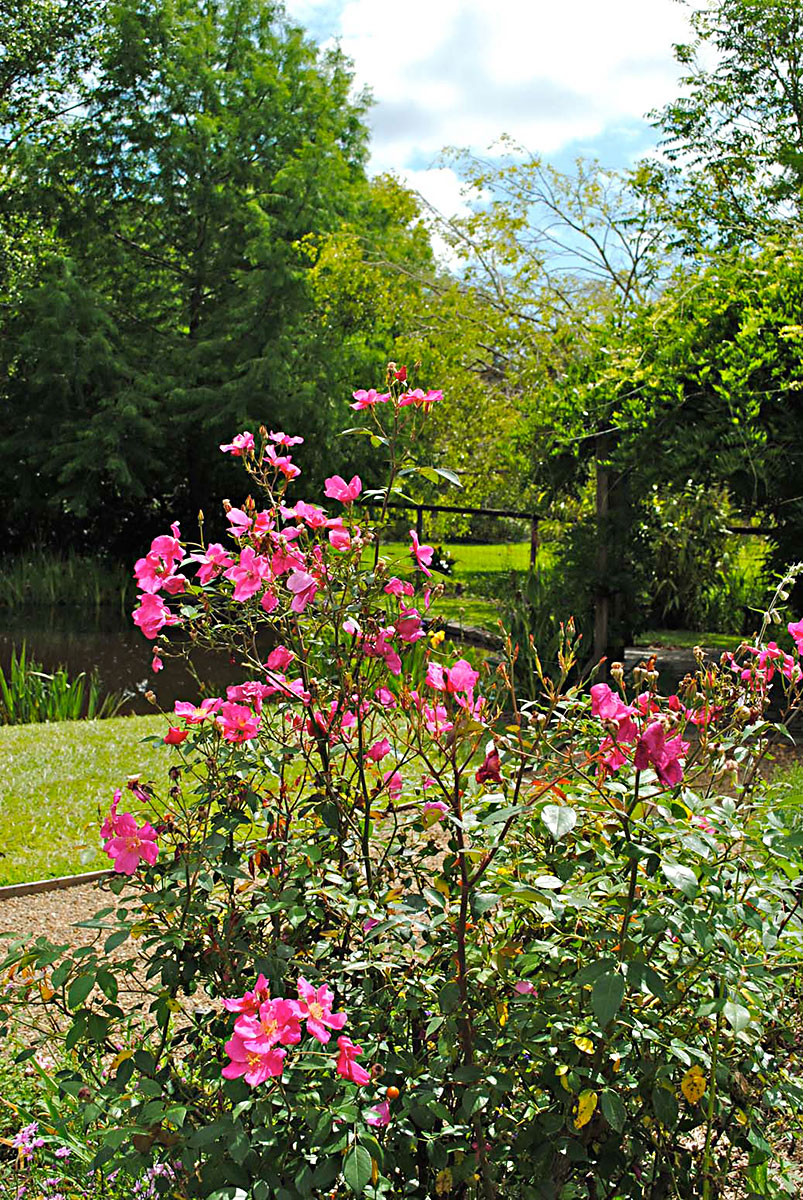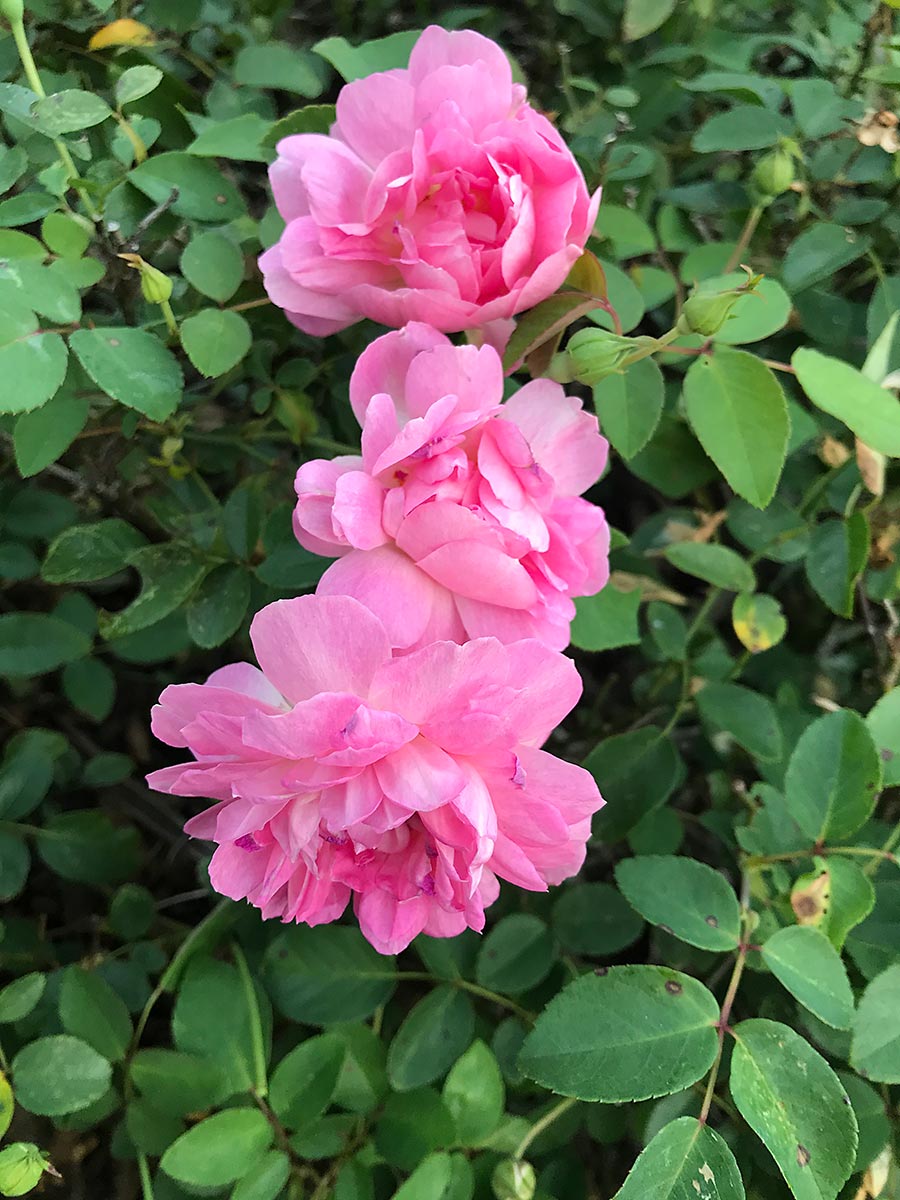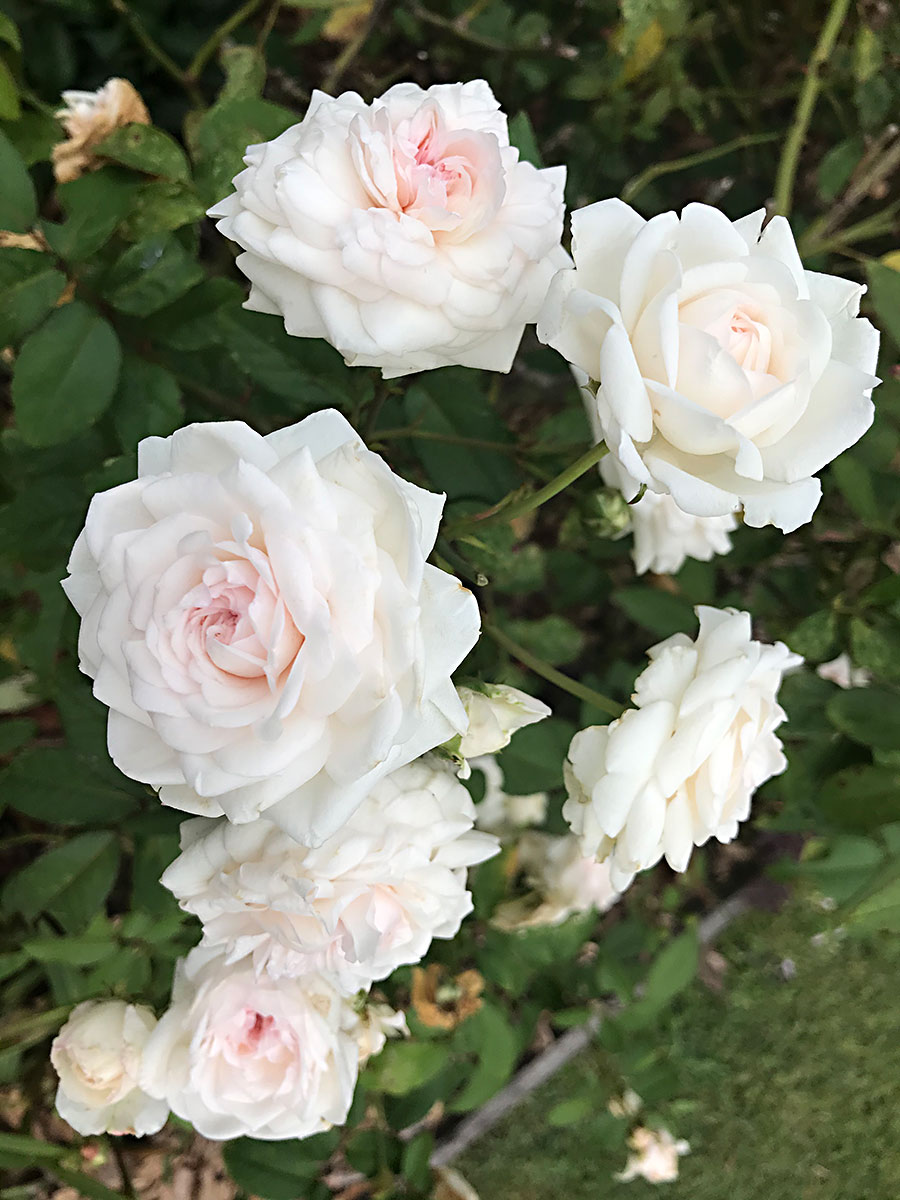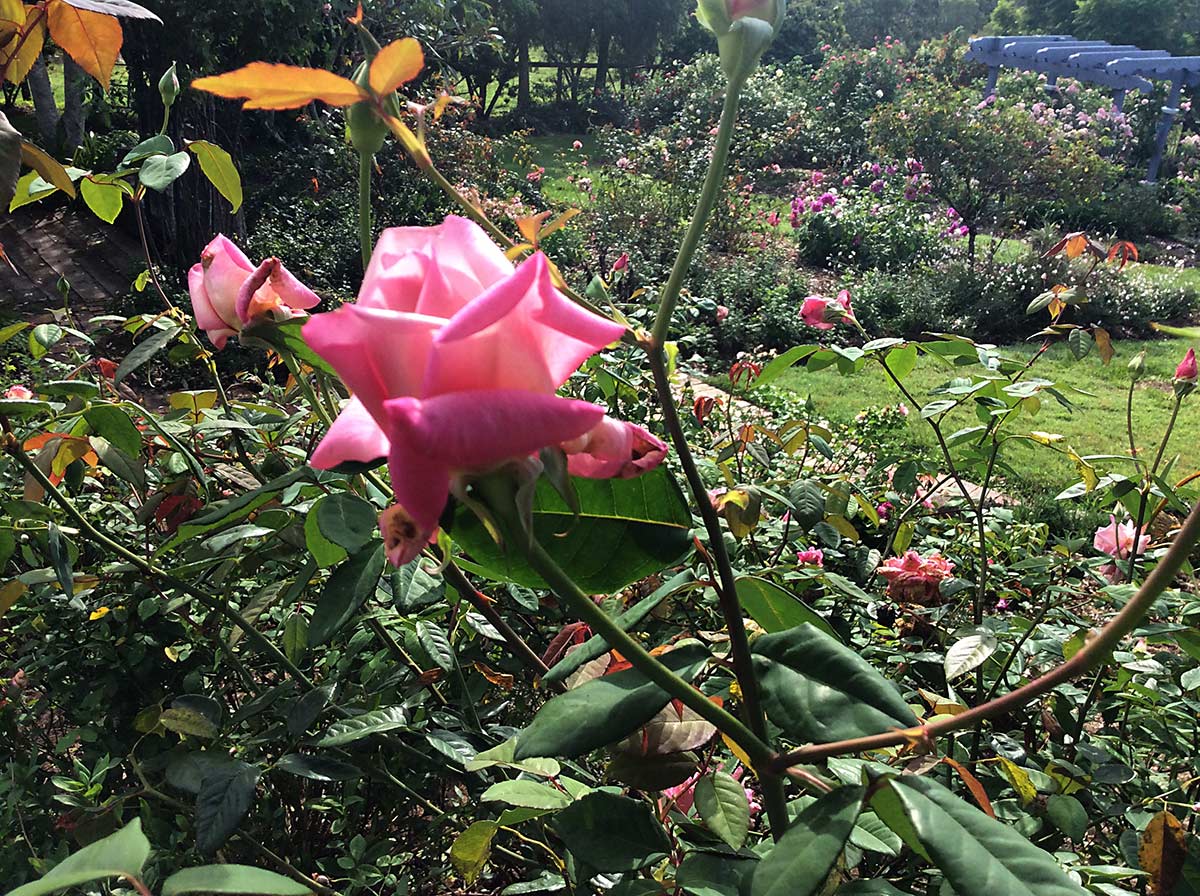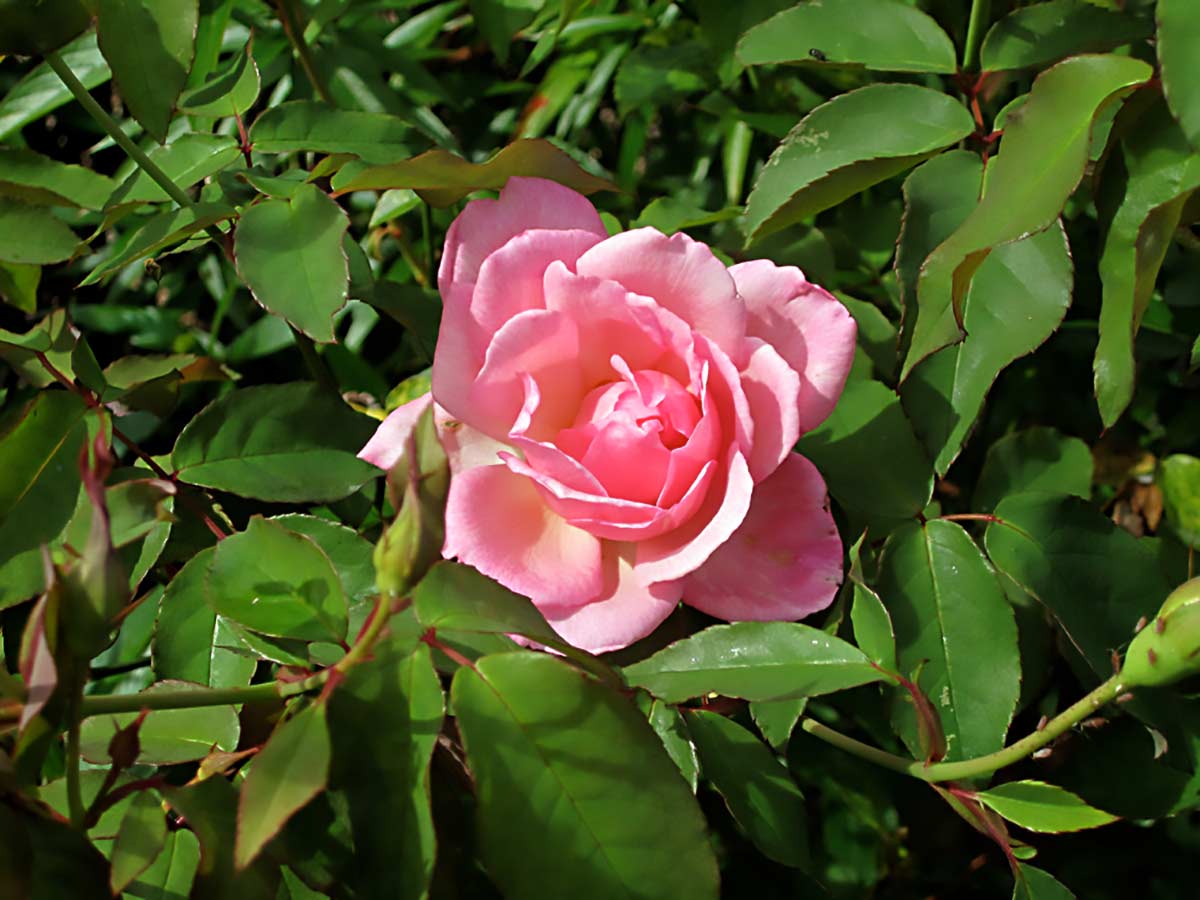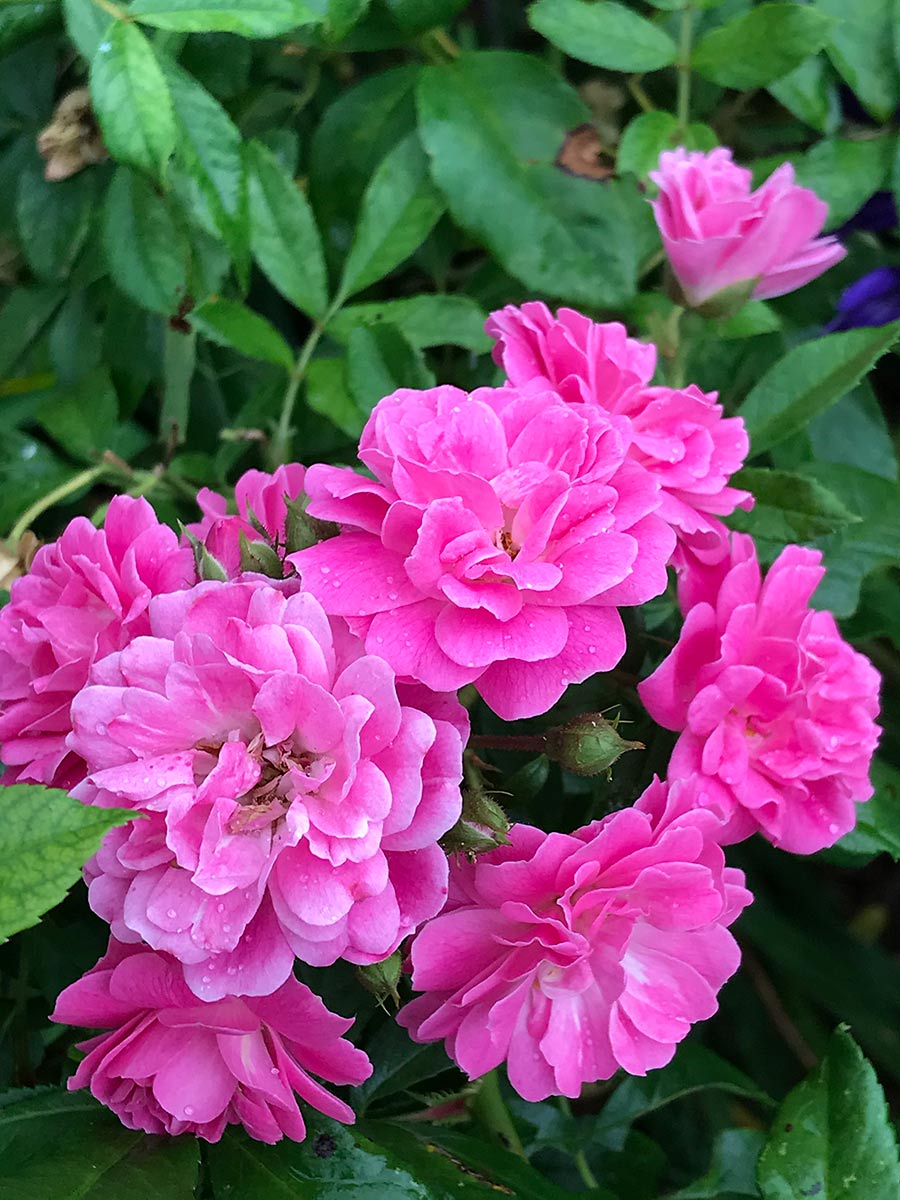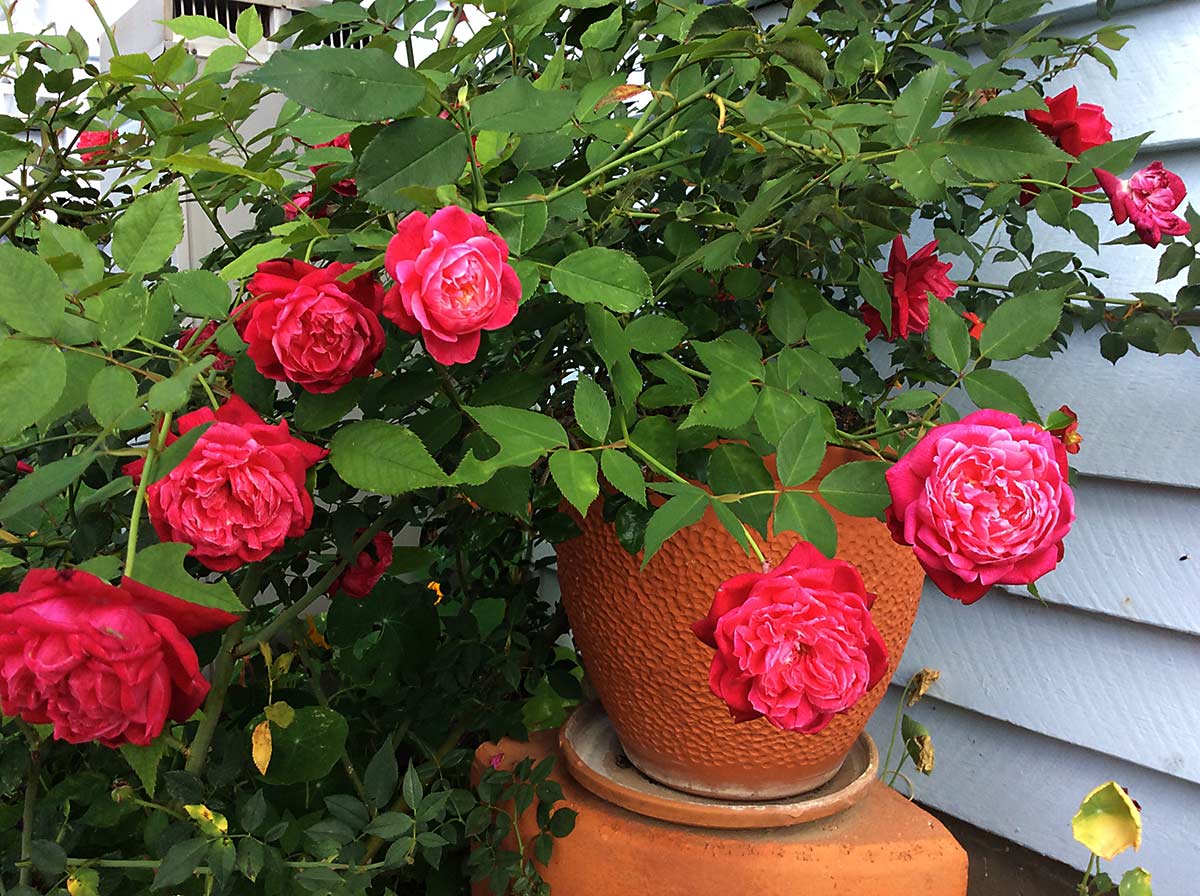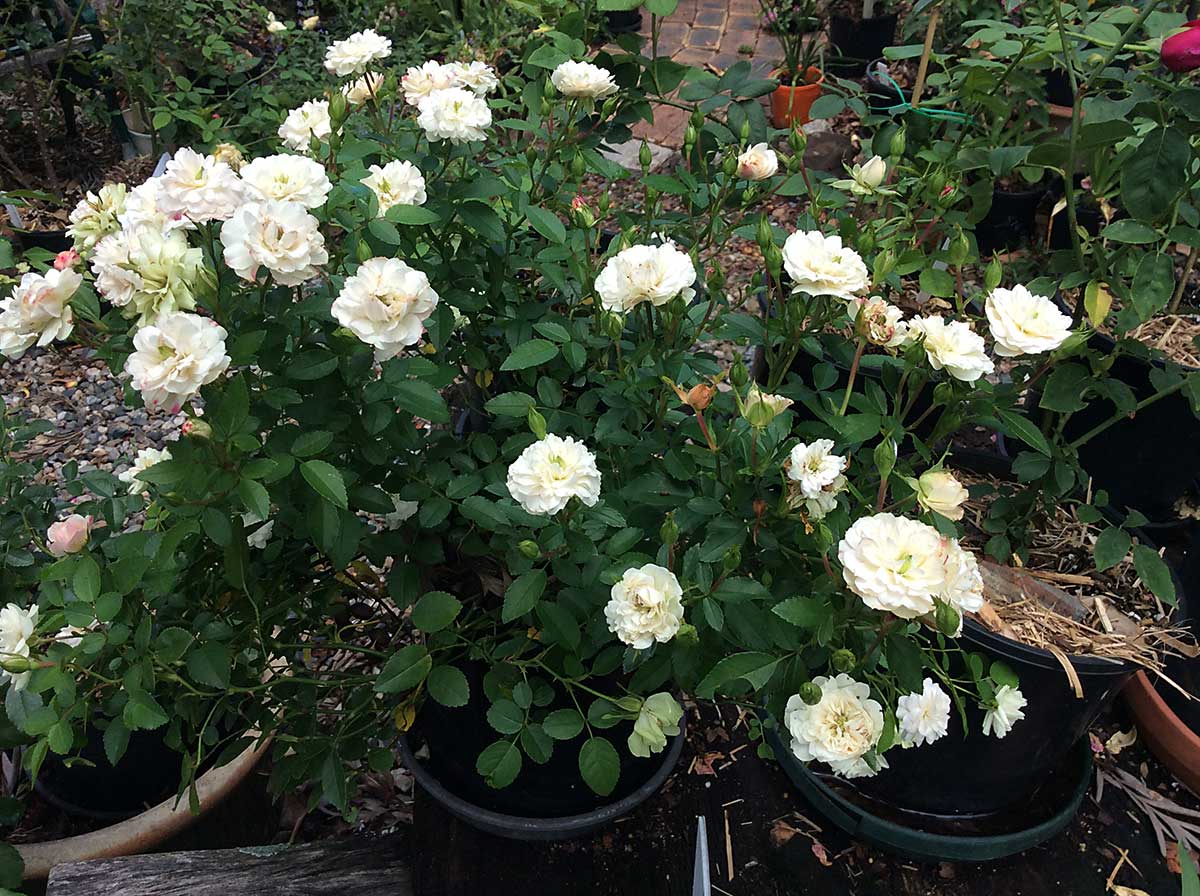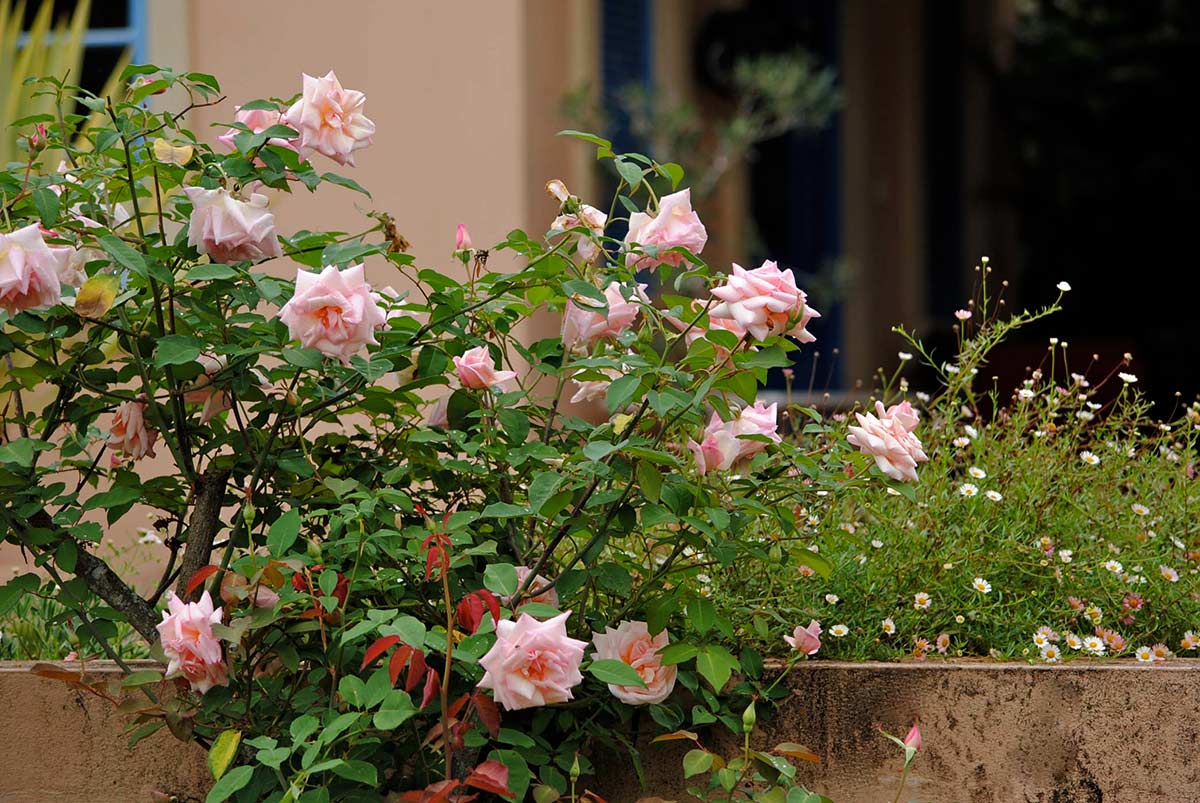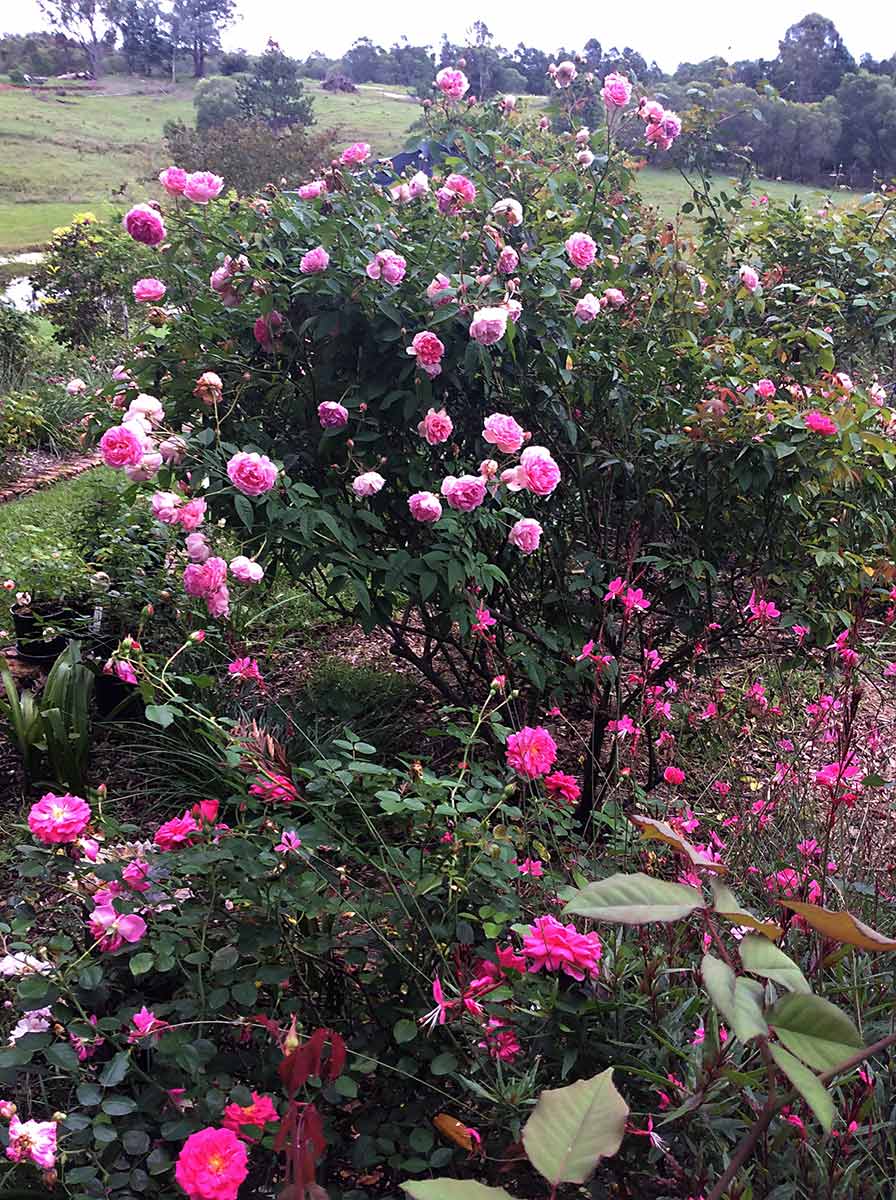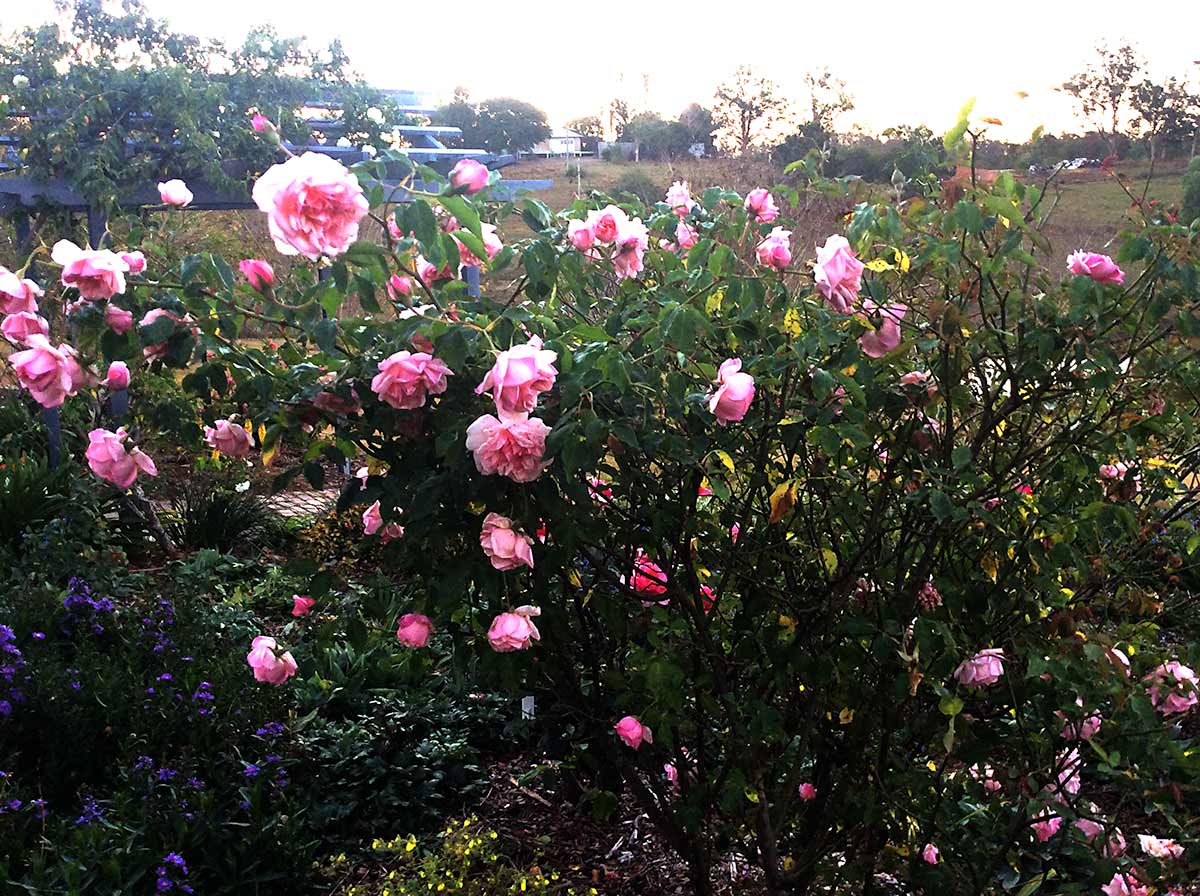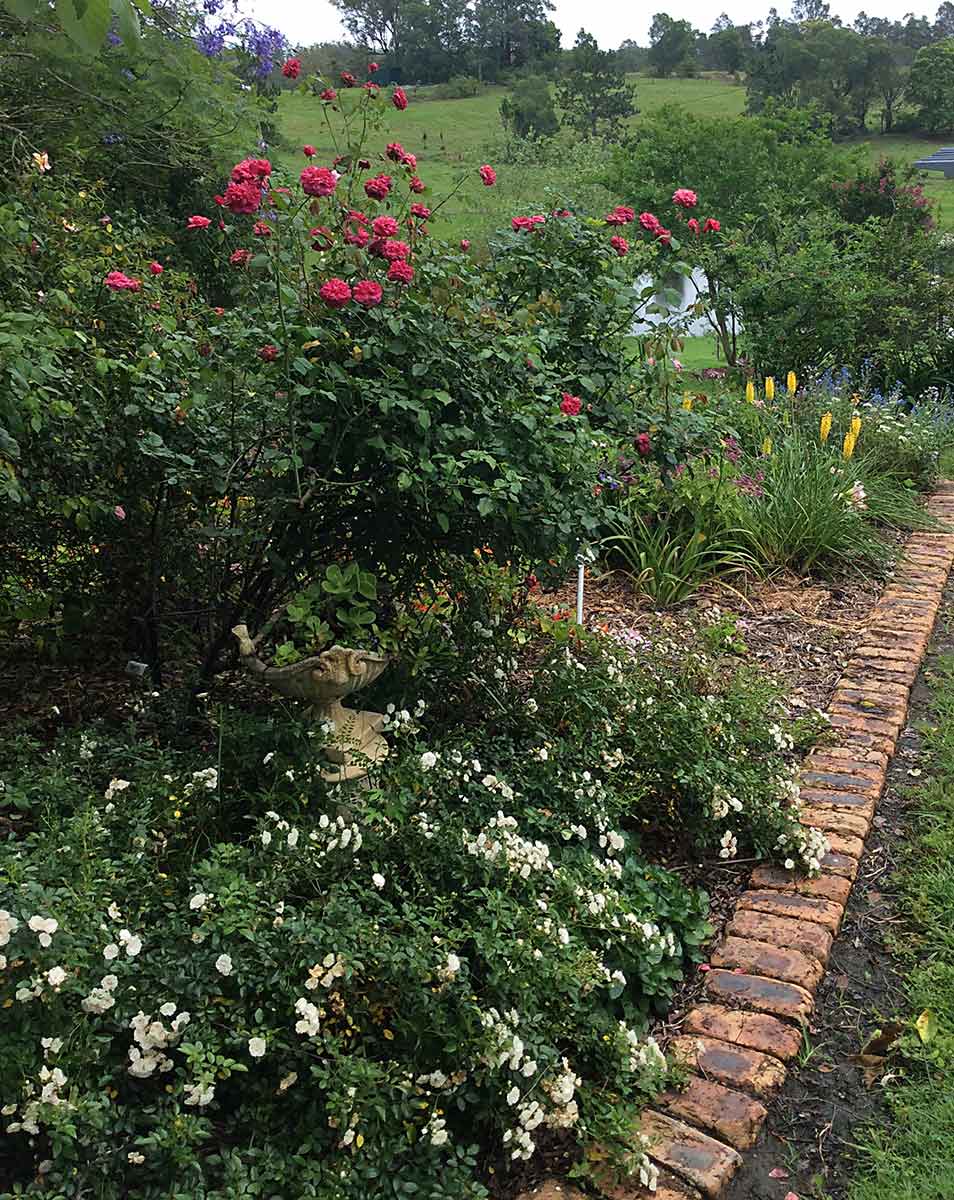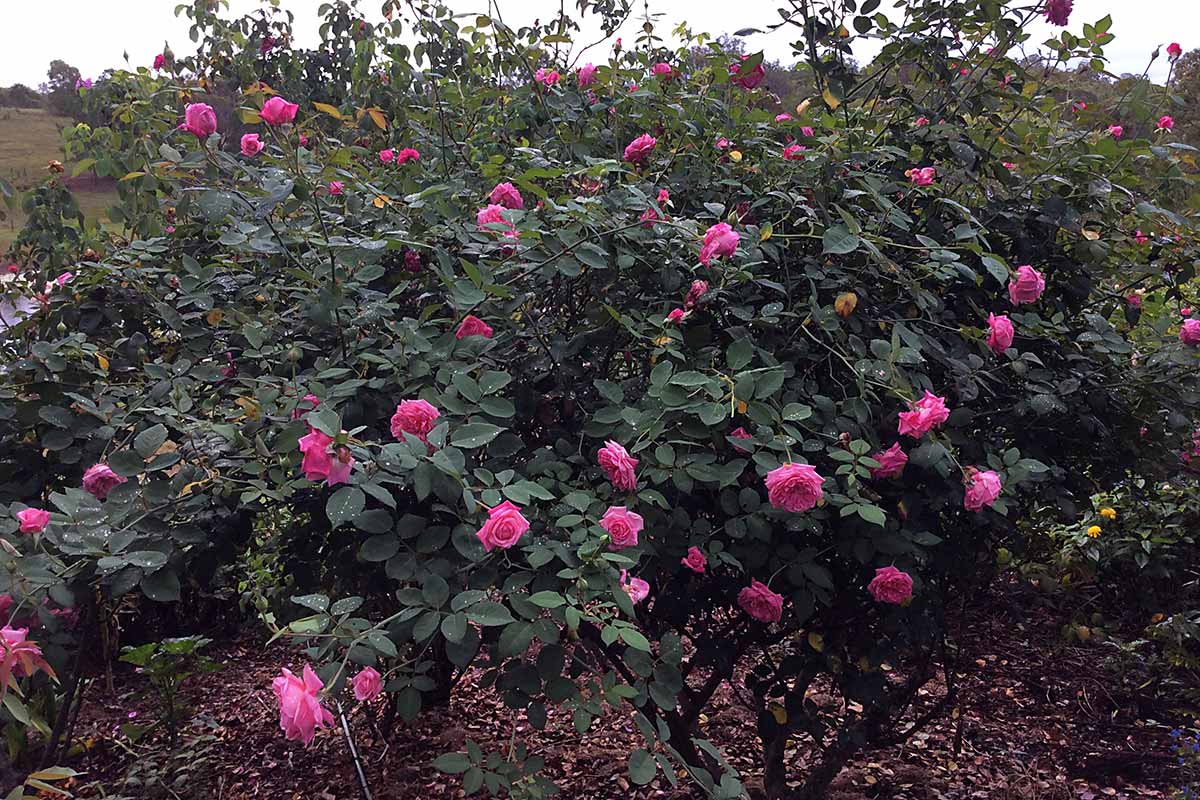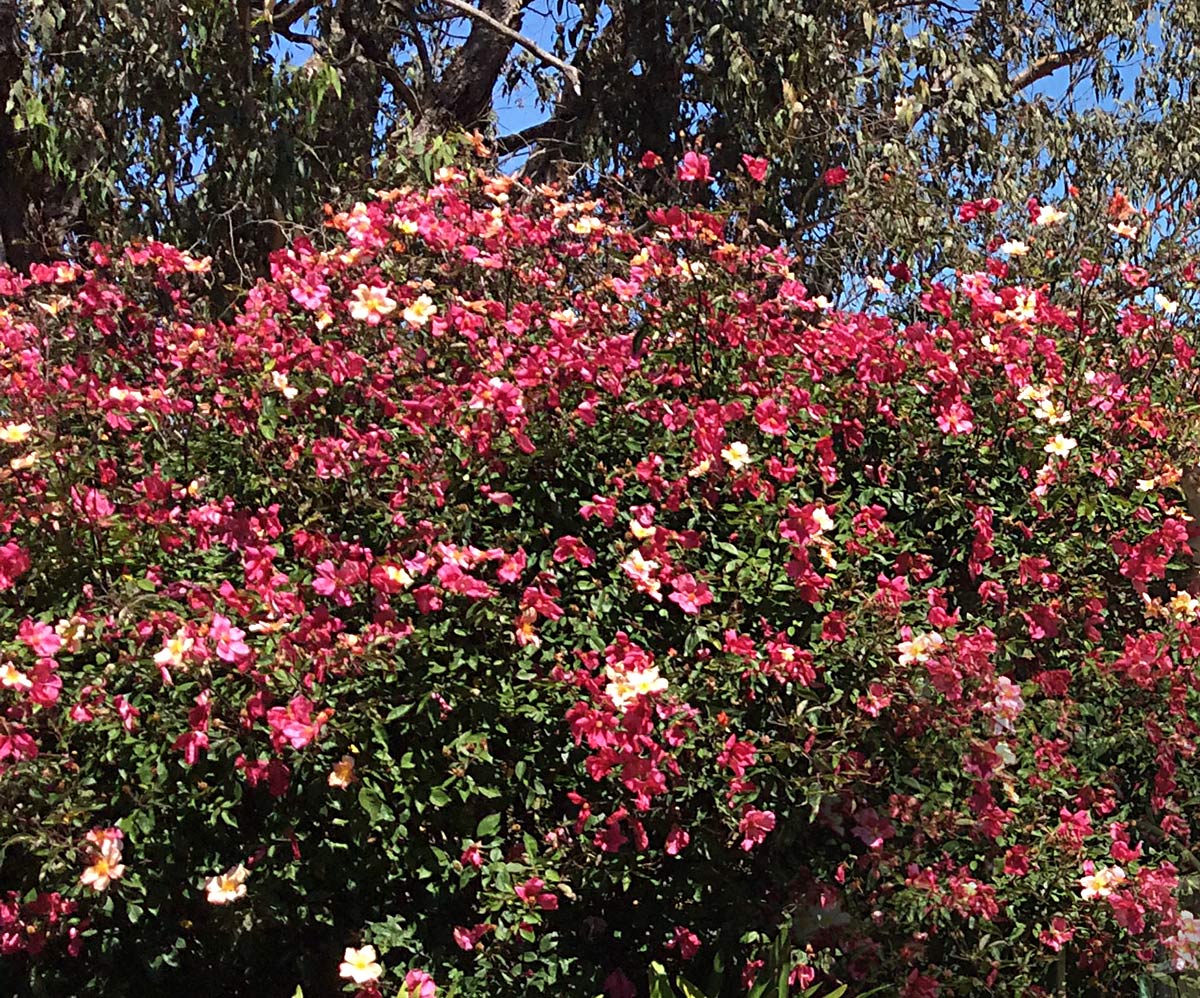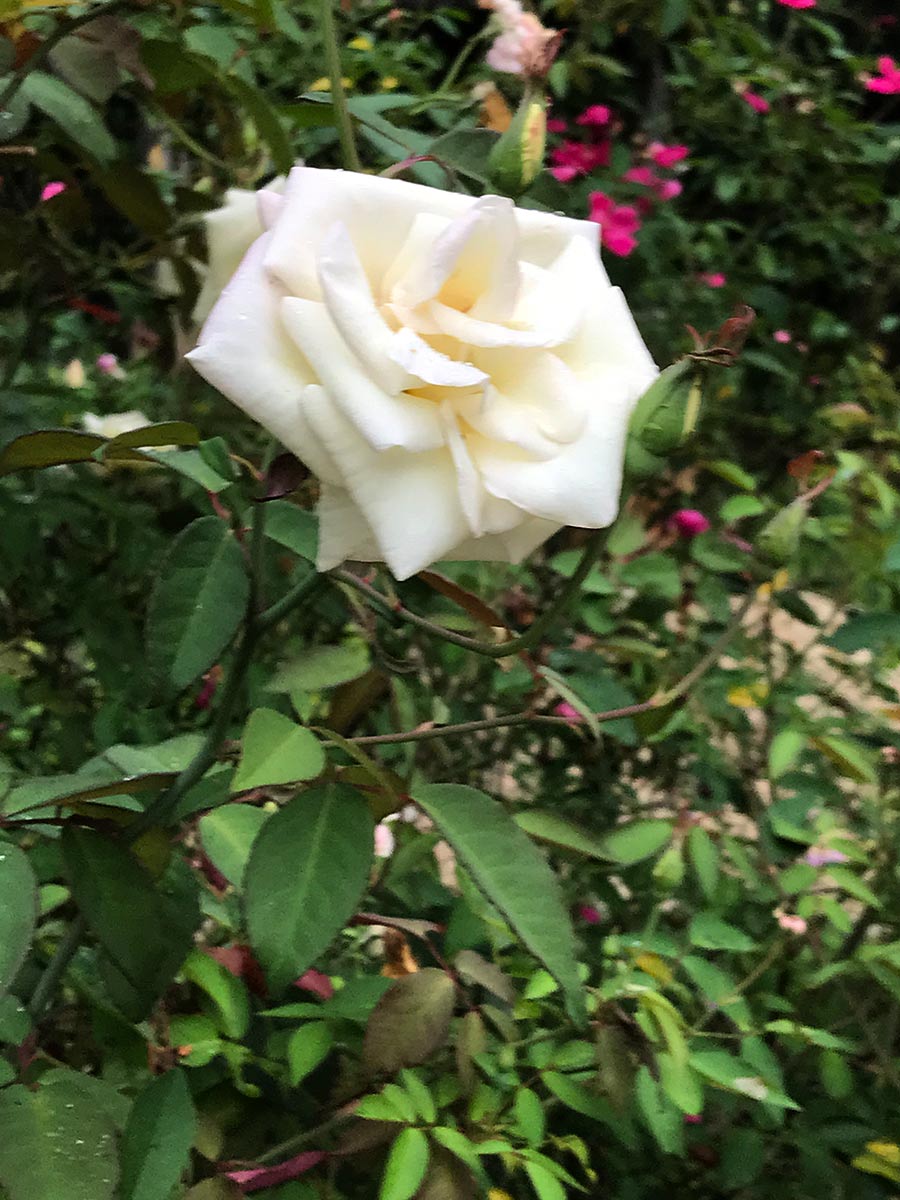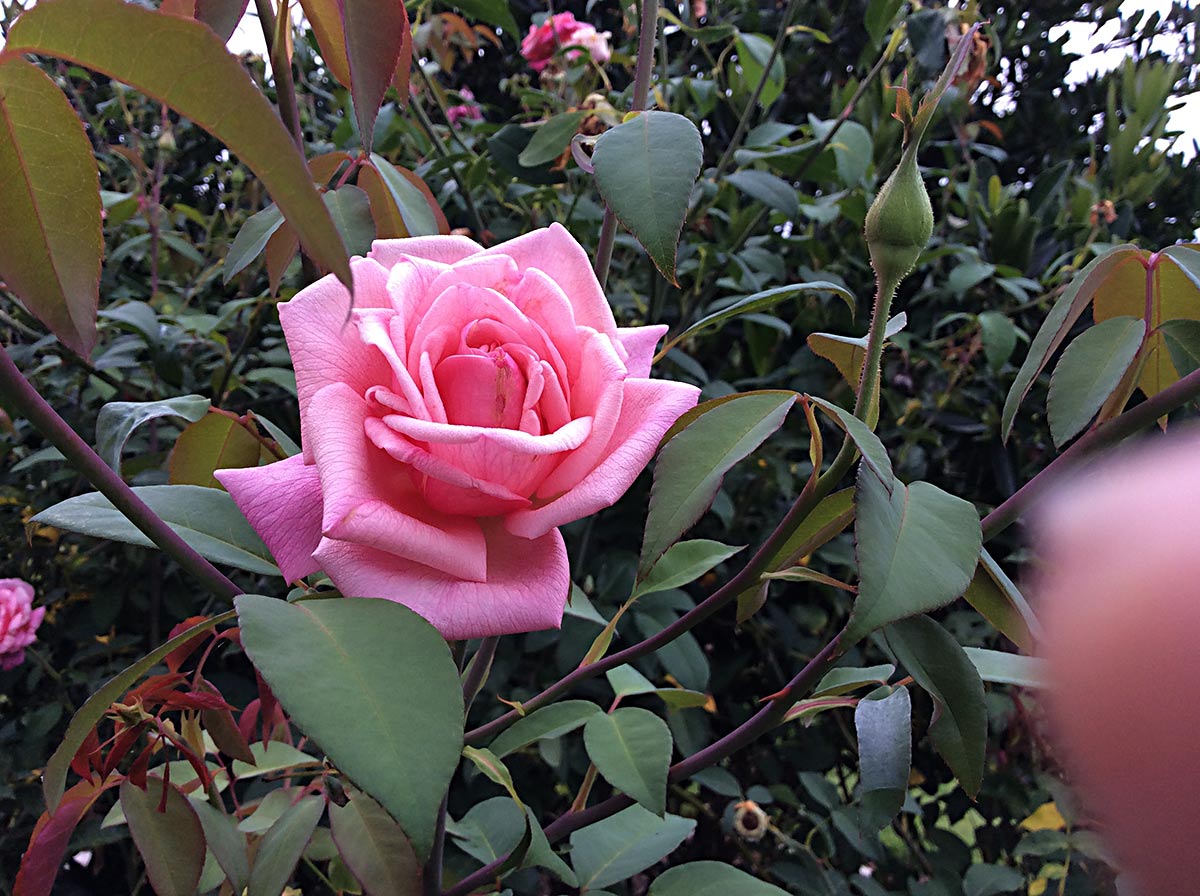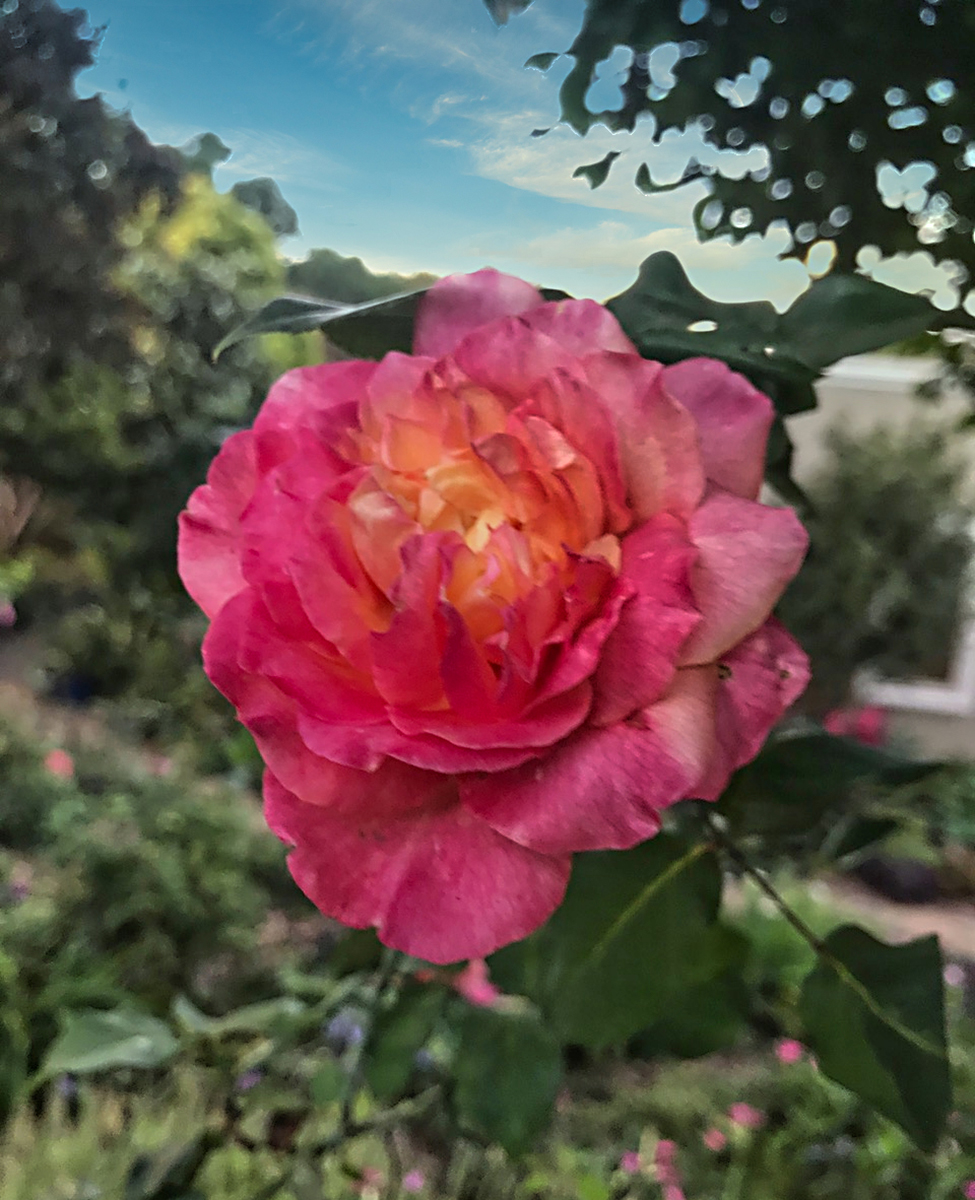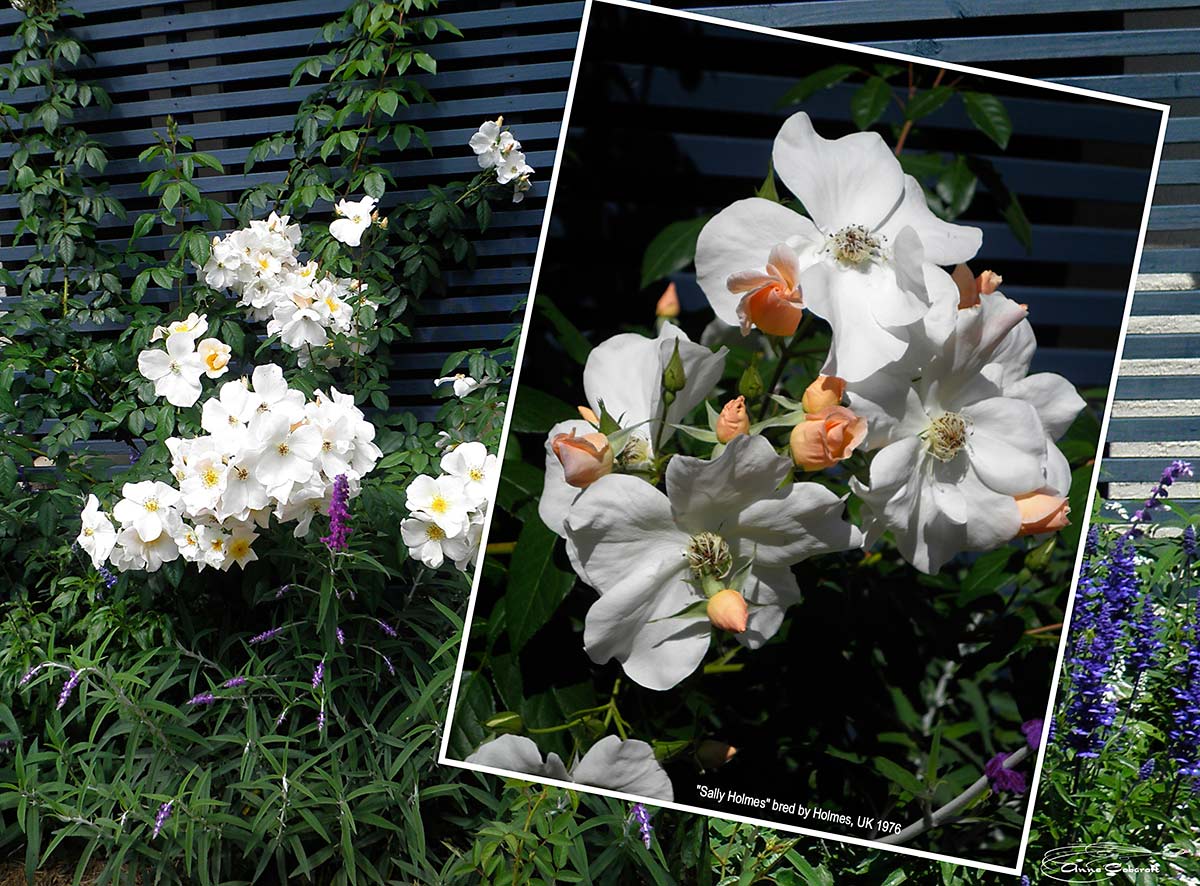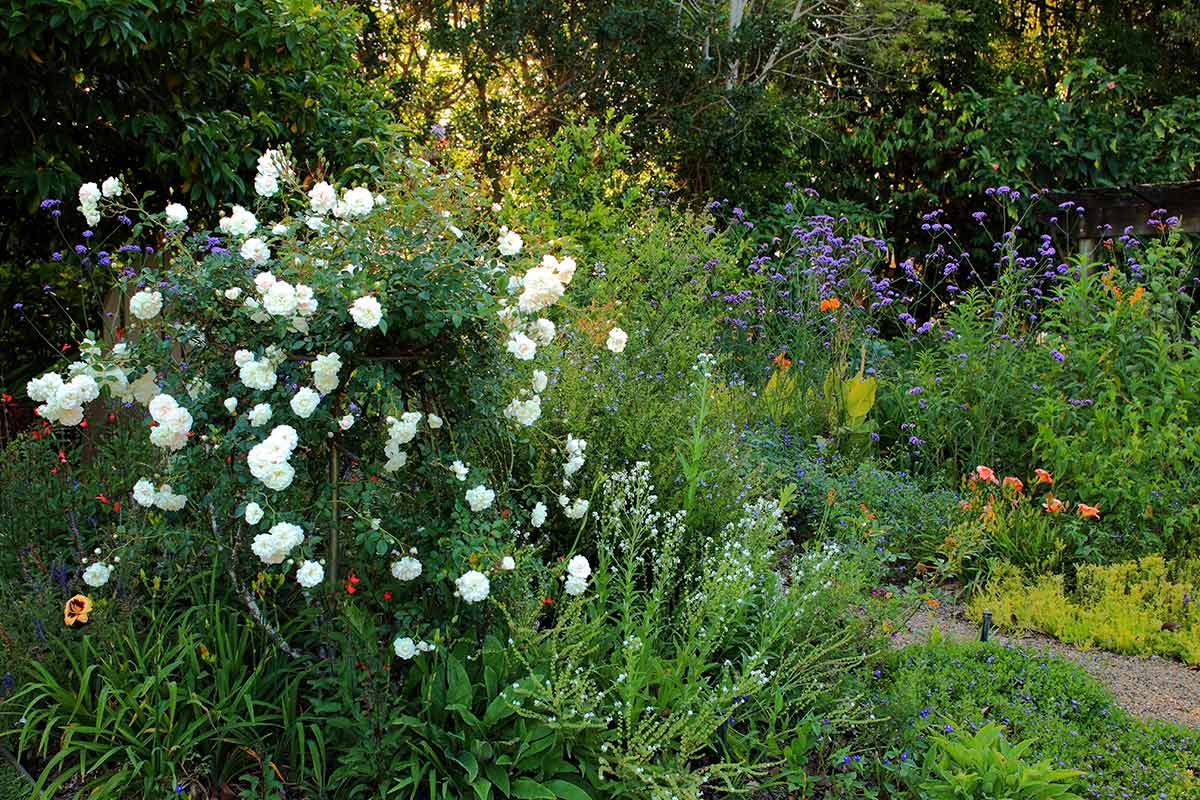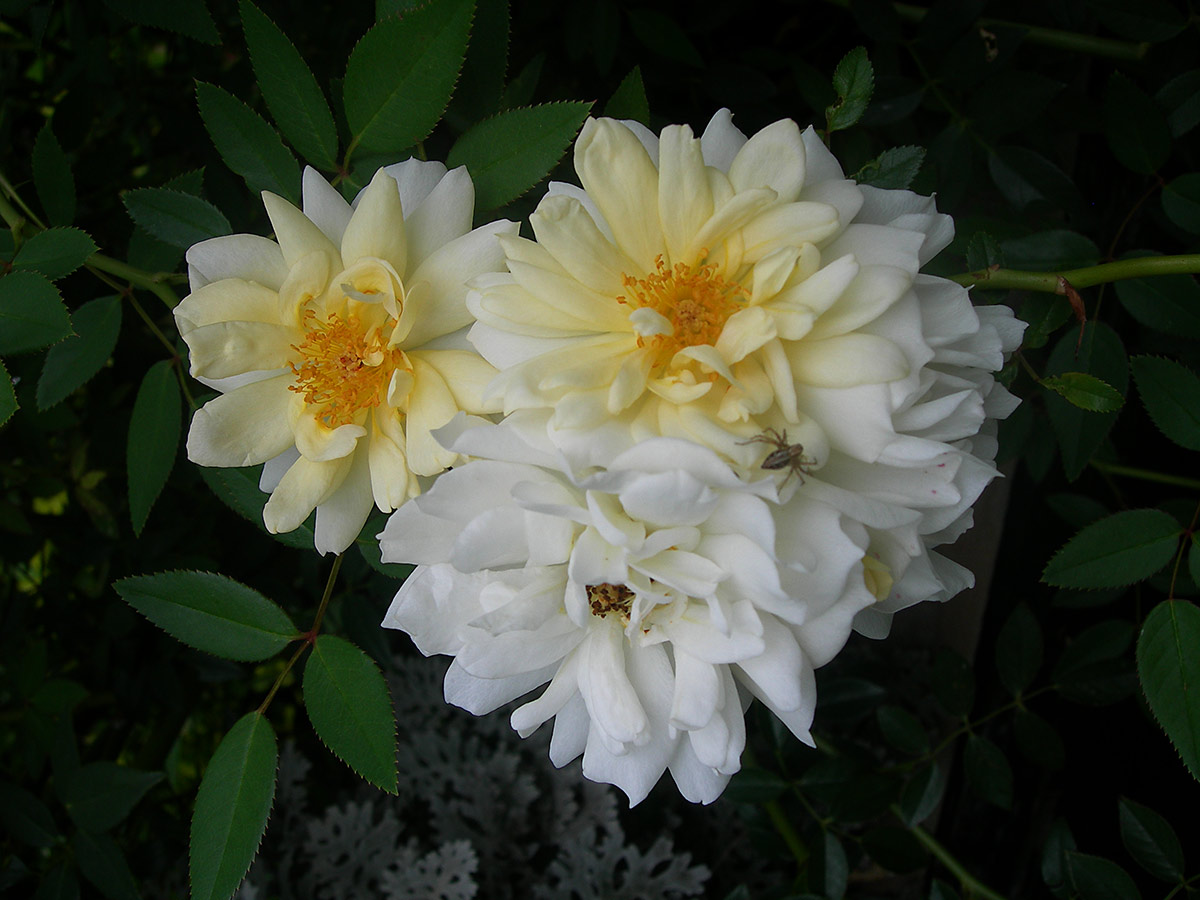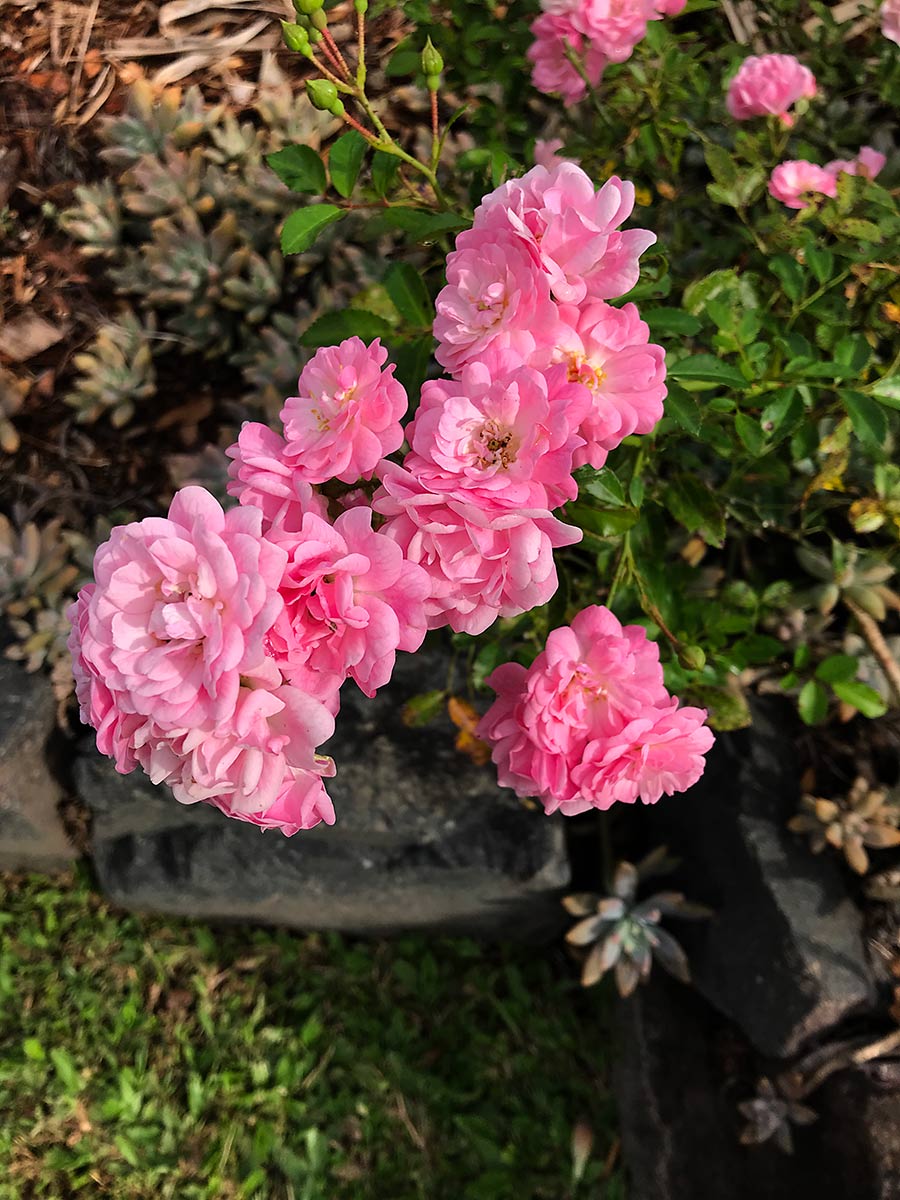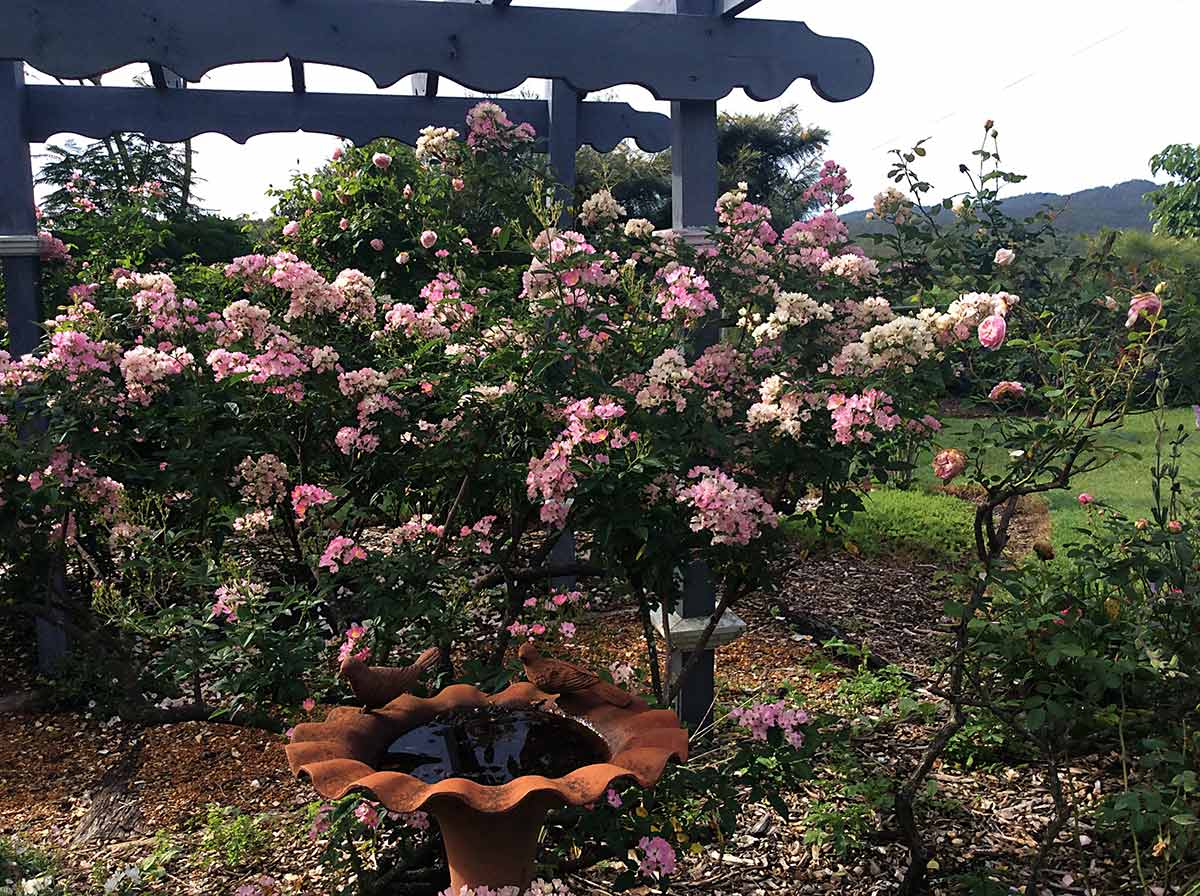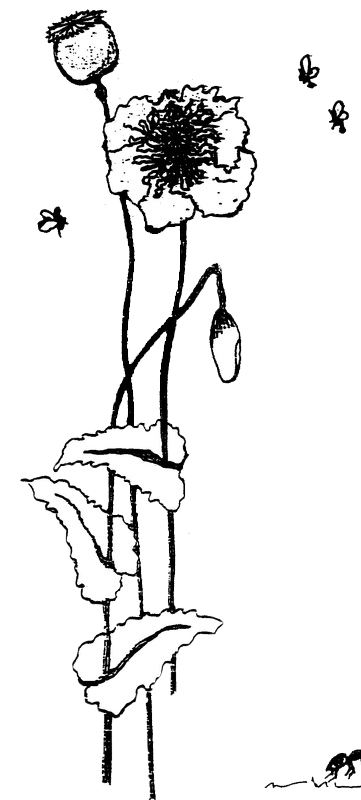
Roses in
southeast
Queensland
‘promoting cottage gardening
in southeast Queensland’
Roses suitable for the subtropics
Growing roses in southeast Queensland can be a very rewarding pastime. Here we feature a variety of roses grown by Perennial Poppies Group members across the region. Those featured will change regularly so check back from time to time for more information or visit our rose gallery to look at more lovely images of roses suitable for southeast Queensland.
This is a list, in no order of preference, of roses that are outstanding in southeast Queensland. There are many others that also deserve consideration. These roses have been grown for an extended period in gardens in our region and assessed as to their suitability in our humid climate. Not for a minute is it suggested that of the thousands of roses on the market these are the only one to grow. There are many dedicated rose growers achieving great results with modern new release roses and credit is gladly given to them.
When creating gardens and making an area around the home where gardeners, children, birds and wild life can exist in harmony without the use of harmful chemicals, these roses can be recommended as resilient, tough and generous with their beauty. Avoiding the use of harmful chemicals is most important and by including predator insect attracting perennials, nature can work in harmony. Roses need at least 4 hours of sunlight per day, preferably morning sun. Competition from trees and large shrubs should be avoided if possible. Extra water and feeding will be necessary if grown in this situation.
Companion plants such as perennials and bulbs add to the joy of growing roses. Plants such as dianthus, penstemon, angelonia, salvias, lavender, heliotrope, iris, hippeastrum, freesia, babiana, kniphofia, daylilies, ifafa lilies, catmint, geraniums and pansies are just a few plants that complement roses. Alyssum is an annual that attracts predator insects and looks wonderful in a cottage garden. Beware of aggressive plants such as mint, agapanthus, evening primrose, chrysanthemum and Australian native violets. All are lovely but compete vigorously for water and nutrients.
Mulch roses deeply, using mulch which breaks down readily like lucerne or sugar cane mulch. If possible, spread a thin layer of cow or stable manure or organic fertiliser spread around roses before the mulch goes on as this will give excellent results. Regular feeding is desirable for good year-round performance. Many gardeners feel there is a secret recipe for growing healthy rose bushes that produce plenty of flowers. A regular program helps to achieve this.
Roses perform at their best with care and maintenance throughout the year.
Spring: When the new shoots appear after winter pruning, fertilise with a complete fertiliser like Eco 88®, rose food or fruit tree fertiliser. Water in well.
November: Fertilise with a couple of handfuls of Organic Xtra® per bush.
January: Fertilise with some blood and bone with approximately 10% of potash added.
March: Fertilise with Organic Xtra® again.
May: Fertilise with some animal manure if possible or blood and bone with 10% potash extra.
This is just a guide and can be adapted to your own requirements.
Old-fashioned roses are popular because of their disease resistance. There may be a few black spots on foliage at certain times of the year but generally a light prune and a foliage spray with a seaweed mixture will help the plants to overcome it. Remember they have survived around homesteads for hundreds of years without help from chemical sprays. Milk spray at the rate of 10:1 water to milk is excellent for mildew. Aphids can be a problem in early spring. Try spraying them with a strong jet of water. If unbearable you can use pyrethrum but remember to spray early morning or late afternoon to avoid harming the beneficial insects. Pyrethrum is a natural spray but must be used with caution. Attract birds into the garden to assist with control of caterpillars.
Pruning can be as much or as little as you like. Always take out the dead wood first and any twiggy growth. Winter pruning invigorates plants. A trim in the latter part of summer (February) is a good idea, as then a lovely autumn flush will result, often giving the best roses of the year. Deadheading all year is a form of pruning, helping to keep the bushes tidy and producing new growth.
The beauty of the old rose varieties is they are known survivors having been found in neglected farmhouse gardens, deserted home sites and even cemeteries. That these wonderful roses still flourish without human intervention is evidence of their toughness. Often these early roses were brought out here on long sea voyages by early settlers, then shared around by cuttings in the new country. These are the plants that have survived the test of time.
Growing old-fashioned roses on their own roots has advantages as many gardeners are realising. Generally, roses from the south are grafted on to a rootstock which is suitable for western NSW, Victoria and South Australia. Two advantages of cutting grown roses are that there will be no suckering from the rootstock or reverting back to rootstock and secondly once established a plant with a very healthy root system will support a rose bush able to cope in our climatic conditions. If you are interested in roses grown on their own roots please contact Leonie Kearney.
Leonie Kearney
Rosevale Homestead
922 Mt Samson Rd, Samsonvale
Ph: 0408 515 454
Email: lk001@tpg.com.au
Open Saturdays 9am to 5pm (phone for an appointment at other times).
Recommended rose book: Old-fashioned roses in a subtropical climate is available from the author, Leonie Kearney.
Growing roses organically
Read More
Qld Organics products, Organic Xtra® and Eco88® are excellent to use on roses. Most nurseries and hardware stores stock both products and they are very easy to use. Alternate these products and when foliar feeding, try Plant of Health® products marketed by Batphone Australia.
Many companies market seaweed fertilisers. Seasol® is an excellent product and used in conjunction with its sister product Powerfeed® great results can be gained. Both products are used as foliar fertilisers. When planting, soak the plant in a solution of seaweed and put a handful of Organic Xtra® in the planting hole and water the plant in with the seaweed mixture. Be sure to water in any pelletised or granular fertilisers. Seaweed fertilisers can assist plants to cope with frost and heat stress.
When pruning, use the cut and drop method (not rose cuttings please) and then spread a dry fertiliser before mulching over the top and watering in. There are many organic fertilisers on the market so choose carefully.
To have roses grow successfully without the use of harmful chemicals, predator insects must be encouraged into the garden to do some of the work for us. Green Harvest Organic Garden Supplies at Maleny have a very informative website and offer a range of products that can assist. https://greenharvest.com.au/
Qld Organics products, Organic Xtra® and Eco88® are excellent to use on roses. Most nurseries and hardware stores stock both products and they are very easy to use. Alternate these products and when foliar feeding, try Plant of Health® products marketed by Batphone Australia.
Many companies market seaweed fertilisers. Seasol® is an excellent product and used in conjunction with its sister product Powerfeed® great results can be gained. Both products are used as foliar fertilisers. When planting, soak the plant in a solution of seaweed and put a handful of Organic Xtra® in the planting hole and water the plant in with the seaweed mixture. Be sure to water in any pelletised or granular fertilisers. Seaweed fertilisers can assist plants to cope with frost and heat stress.
When pruning, use the cut and drop method (not rose cuttings please) and then spread a dry fertiliser before mulching over the top and watering in. There are many organic fertilisers on the market so choose carefully.
To have roses grow successfully without the use of harmful chemicals, predator insects must be encouraged into the garden to do some of the work for us. Green Harvest Organic Garden Supplies at Maleny have a very informative website and offer a range of products that can assist. https://greenharvest.com.au/
Proven performers for the subtropics
Small growers
Small growers
‘Australia Felix’
‘Bernice Mitchell’s Rose’
‘Bobby James’
‘Borderer’
‘Cameo’
‘Captain Watkins’
‘Green Ice’
‘Hazel Anne’
‘Irene Watts’
‘Lavinia Evens’
‘Orleans Rose’
‘Papa Hemeray’
‘Pink Dreams’
‘Popcorn’
‘Rose Marsh’s Polyantha’
‘Softee’
‘Stan’s Laidley Rose’
‘Suitor’
‘The Fairy’ – Pink, White and Red
Slightly taller, medium height to 1 meter
Slightly taller, medium height to 1 meter
‘Cecile Brunner’
‘Garden of St Erth’
‘The Straw Rose’
‘Un-named Single Pink’
‘Victoria’s Pride’
‘Wirriana White Fairy’
‘Australia Felix’
‘Bernice Mitchell’s Rose’
‘Bobby James’
‘Borderer’
‘Cameo’
‘Captain Watkins’
‘Green Ice’
‘Hazel Anne’
‘Irene Watts’
‘Lavinia Evens’
‘Orleans Rose’
‘Papa Hemeray’
‘Pink Dreams’
‘Popcorn’
‘Rose Marsh’s Polyantha’
‘Softee’
‘Stan’s Laidley Rose’
‘Suitor’
‘The Fairy’-Pink, White and Red
Medium growers
Medium growers
‘Archduke Charles’
‘Caprice’
‘Claret Cup’
‘Cornelia’
‘Cramoisi Superieur’
‘Duchesse de Brabant’
‘Excellenz von Schubert’
‘Gartendirektor Otto Linne’
‘Gay Vista’
‘Lavender Dreams’
‘Le Vesuve’
‘Madame Antoine Mari’
‘Madame Berkeley’
‘Madame Joseph Schwartz’
‘Penelope Musk’
‘Perle d’Or’
‘Prosperity’
‘Sally Holmes’
‘Snow Spray’
‘Spring Song’
‘Archduke Charles’
‘Caprice’
‘Claret Cup’
‘Cornelia’
‘Cramoisi Superieur’
‘Duchesse de Brabant’
‘Excellenz von Schubert’
‘Gartendirektor Otto Linne’
‘Gay Vista’
‘Lavender Dreams’
‘Le Vesuve’
‘Madame Antoine Mari’
‘Madame Berkeley’
‘Madame Joseph Schwartz’
‘Penelope Musk’
‘Perle d’Or’
‘Prosperity’
‘Sally Holmes’
‘Snow Spray’
‘Spring Song’
‘Cecile Brunner’
‘Garden of St Erth’
‘The Straw Rose’
‘Un-named Single Pink’
‘Victoria’s Pride’
‘Wirriana White Fairy’
Well mannered climbers
Well mannered climbers
These will cover an arch or trellis and repeat flower regularly
‘Clair Matin’
‘Crepescule’
‘Renae’
These will cover an arch or trellis and repeat flower regularly
‘Clair Matin’
‘Crepescule’
‘Renae’
Large climbing roses
Large climbing roses
‘Climbing Duchesse De Brabant’
‘Climbing Cecile Brunner’
‘Lamarque’
‘Madame Alfred Carriere’
‘Reve D’or’
‘Rose Hedge Cottage Pink’
‘Climbing Duchesse De Brabant’
‘Climbing Cecile Brunner’
‘Lamarque’
‘Madame Alfred Carriere’
‘Reve D’or’
‘Rose Hedge Cottage Pink’
Tall growers
Tall growers
‘Anna Olivier’
‘Bloomfield Abundance’
‘Bon Silene’
‘Dr Grill’
‘Etoile de Lyon’
‘Jean Ducher’
‘Madame de Tartas’
‘Maman Cochet’
‘Monsieur Tillier’
‘Mrs B R Cant’
‘Mrs Dudley Cross’
‘Mutabilis’
‘Octavius Weld’
‘Papillon’
‘Peace 1902’
‘Rosette Delizy’
‘Triomphe du Luxembourg’
’Princess de Sagan’
Madame Lombard’
‘Anna Olivier’
‘Bloomfield Abundance’
‘Bon Silene’
‘Dr Grill’
‘Etoile de Lyon’
‘Jean Ducher’
‘Madame de Tartas’
‘Maman Cochet’
‘Monsieur Tillier’
‘Mrs B R Cant’
‘Mrs Dudley Cross’
‘Mutabilis’
‘Octavius Weld’
‘Papillon’
‘Peace 1902’
‘Rosette Delizy’
‘Triomphe du Luxembourg’
’Princess de Sagan’
Madame Lombard’
‘Beauty of Glenhurst’
‘Beauty of Glenhurst’ 1979. This rose was introduced by Trevor Nottle in 1985 and grown by June and Brian Morley at Gummeracha in SA. It was discovered in a batch of seedlings from the ‘Monthly Rose’ (sometimes known as ‘Old Blush’). It was raised from seed collected in 1979 and grown in 1980. Very little information is available on this rose. Its single blooms are magenta-pink fading to paler pink and are continual. Will grow in excess of 2m but it can be pruned to keep it more compact.
‘Beauty of Glenhurst’ 1979. This rose was introduced by Trevor Nottle in 1985 and grown by June and Brian Morley at Gummeracha in SA. It was discovered in a batch of seedlings from the ‘Monthly Rose’ (sometimes known as ‘Old Blush’). It was raised from seed collected in 1979 and grown in 1980. Very little information is available on this rose. Its single blooms are magenta-pink fading to paler pink and are continual. Will grow in excess of 2m but it can be pruned to keep it more compact.
‘Borderer’
‘Borderer’ was bred by Alister Clark, Australia, 1918. A low grower suitable for the edge of a border and grows to 0.5m. It has double salmon-pink flowers with petals which open flat. It is recurrent.
This is an excellent rose for tub specimens. It has very few prickles, a bonus.
‘Borderer’ was bred by Alister Clark, Australia, 1918. A low grower suitable for the edge of a border and grows to 0.5m. It has double salmon-pink flowers with petals which open flat. It is recurrent.
This is an excellent rose for tub specimens. It has very few prickles, a bonus.
‘Clothilde Soupert’
‘Clothilde Soupert’ released in Luxembourg, 1890. This is a low growing rose bearing sweetly scented, tightly packed, very double palest pink and milky white petals. The flowers have a delightful old-fashioned look. Wet weather can cause the flowers to brown, however it flowers extremely well in drier conditions.
‘Clothilde Soupert’ released in Luxembourg, 1890. This is a low growing rose bearing sweetly scented, tightly packed, very double palest pink and milky white petals. The flowers have a delightful old-fashioned look. Wet weather can cause the flowers to brown, however it flowers extremely well in drier conditions.
'Dr Gill'
‘Dr Grill’ was bred by Bonnaire, France 1886. A lovely rose with large, full creamy pink blooms lightly blushed with deeper pink towards the edges. The blooms are silken with a tight petalled high centre and a delicious perfume. Dr Grill, like most Teas will bloom right into winter. It grows into a tall handsome shrub.
‘Dr Grill’ was bred by Bonnaire, France 1886. A lovely rose with large, full creamy pink blooms lightly blushed with deeper pink towards the edges. The blooms are silken with a tight petalled high centre and a delicious perfume. Dr Grill, like most Teas will bloom right into winter. It grows into a tall handsome shrub.
‘Duchesse de Brabant’
‘Duchesse de Brabant’ was bred by Bernede, France 1857. It is an excellent rose for the Brisbane area. If you are only able to have one rose, this is the rose to have. Flowers are born in clusters and are cupped and double in a beautiful shade of shell-pink. It flowers continuously and a small group of them will ensure flowers all year long. This exquisite rose flower is round like a cabbage, a beautiful shade of pink and the blooms tend to nod on the bush. Red new foliage adds to its charm and the bush is rarely troubled by pests or disease. The plant can grow quite tall, to 2m. Pruning however, will keep the bush to your desired size. This rose was planted around cottages and farmhouses in our colonial days. There is also a climbing form of ‘Duchesse de Brabant’ which is a good grower. ‘Duchesse de Brabant’ also passes as the ‘Montville Rose’, ‘Countess Bertha’ or ‘Comtesse de Lambarthe’.
‘Duchesse de Brabant’ was bred by Bernede, France 1857. It is an excellent rose for the Brisbane area. If you are only able to have one rose, this is the rose to have. Flowers are born in clusters and are cupped and double in a beautiful shade of shell-pink. It flowers continuously and a small group of them will ensure flowers all year long. This exquisite rose flower is round like a cabbage, a beautiful shade of pink and the blooms tend to nod on the bush. Red new foliage adds to its charm and the bush is rarely troubled by pests or disease. The plant can grow quite tall, to 2m. Pruning however, will keep the bush to your desired size. This rose was planted around cottages and farmhouses in our colonial days. There is also a climbing form of ‘Duchesse de Brabant’ which is a good grower. ‘Duchesse de Brabant’ also passes as the ‘Montville Rose’, ‘Countess Bertha’ or ‘Comtesse de Lambarthe’.
‘Gartendirektor Otto Linne’
‘Gartendirektor Otto Linne’ was bred by Lambert, Germany 1934. (Listed as a Modern Shrub Rose in most publications). This is a most vigorous and healthy rose with a neat arching shape and carries its flowers in large trusses of up to 30 flowers. The blooms are a modest size, deep-pink with a touch of yellow at the base and are shaped like pompoms with many small petals. It performs well during the most trying summer. Grows to 1.2m.
‘Gartendirektor Otto Linne’ was bred by Lambert, Germany 1934. (Listed as a Modern Shrub Rose in most publications). This is a most vigorous and healthy rose with a neat arching shape and carries its flowers in large trusses of up to 30 flowers. The blooms are a modest size, deep-pink with a touch of yellow at the base and are shaped like pompoms with many small petals. It performs well during the most trying summer. Grows to 1.2m.
‘Grandma Frederick’s Rose’
‘Grandma Frederick’s Rose’ ROR (Renamed Old Rose for study purposes) was found in a cemetery in South Australia. Very similar to ’Cramoisi Superieur’ with double crimson outer petals and packed in the centre with paler petals. Grows to 1m.
‘Grandma Frederick’s Rose’ ROR (Renamed Old Rose for study purposes) was found in a cemetery in South Australia. Very similar to ’Cramoisi Superieur’ with double crimson outer petals and packed in the centre with paler petals. Grows to 1m.
‘Green Ice’
‘Green Ice’ was bred by Moore, USA 1971. (Listed as a miniature). This dear little rose is very low growing and has tiny double layered blooms which fade to cream to pale green. Deep green foliage compliments it beautifully.
‘Green Ice’ was bred by Moore, USA 1971. (Listed as a miniature). This dear little rose is very low growing and has tiny double layered blooms which fade to cream to pale green. Deep green foliage compliments it beautifully.
‘Jean Ducher’
‘Jean Ducher’ was bred by Ducher, France 1874. Delicate is the best way to describe this rose. Blooms are semi-double peachy cream with an apricot glow. Do not be deceived by its delicacy as it is a vigorous and hardy large rose reaching at least 1.5m.
‘Jean Ducher’ was bred by Ducher, France 1874. Delicate is the best way to describe this rose. Blooms are semi-double peachy cream with an apricot glow. Do not be deceived by its delicacy as it is a vigorous and hardy large rose reaching at least 1.5m.
‘Lionel’s Pink China Rose'
‘Lionel’s Pink China Rose’ was bred at Woodford in Queensland by old-fashioned rose lover, Lionel. A brilliant rose for this climate if you have space for a large plant with a wide canopy that reaches to 2.5m. The double pink roses in upright bunches of 5 to 7 flowers are in many shades of pink, from palest pink to quite dark shades.
It doesn’t stop flowering, has a sweet perfume and has relatively few prickles. Will grow in a more difficult situation and is happy to be trimmed.
‘Lionel’s Pink China Rose’ was bred at Woodford in Queensland by old-fashioned rose lover, Lionel. A brilliant rose for this climate if you have space for a large plant with a wide canopy that reaches to 2.5m. The double pink roses in upright bunches of 5 to 7 flowers are in many shades of pink, from palest pink to quite dark shades.
It doesn’t stop flowering, has a sweet perfume and has relatively few prickles. Will grow in a more difficult situation and is happy to be trimmed.
‘Madame de Tartas’
‘Madame de Tartas’ was bred by Bernede, France 1859. Cupped blush-pink blooms, fully double and slightly fragrant. Will grow to just over 1.5m.
‘Madame de Tartas’ was bred by Bernede, France 1859. Cupped blush-pink blooms, fully double and slightly fragrant. Will grow to just over 1.5m.
‘Monsieur Tillier’
‘Monsieur Tillier’ was bred by Bernaix, France 1891. This is an extraordinary rose, a difficult colour to describe, glowing rich pink washed with tea and a coppery silken glow. The fragrance is gentle and the medium size flowers are cupped with short inner petals and outer petals shell-like, forming a cup. The bush is very vigorous growing to at least 2m, so be warned. Plant it at the back of the bed. It is seldom without flowers and the winter flowers are the loveliest. It is often sold as ‘Archiduc Joseph’.
‘Monsieur Tillier’ was bred by Bernaix, France 1891. This is an extraordinary rose, a difficult colour to describe, glowing rich pink washed with tea and a coppery silken glow. The fragrance is gentle and the medium size flowers are cupped with short inner petals and outer petals shell-like, forming a cup. The bush is very vigorous growing to at least 2m, so be warned. Plant it at the back of the bed. It is seldom without flowers and the winter flowers are the loveliest. It is often sold as ‘Archiduc Joseph’.
‘Mrs B R Cant’
‘Mrs B R Cant’ was bred by B R Cant, UK 1901. Very full-cupped double and quartered rich rose-pink blooms, so large they nod on the plant. Fragrance is outstanding and long stems make it a good cutting rose. This rose is an abundant and constant bloomer and loves a warm climate. Grows to around 1.8m.
‘Mrs B R Cant’ was bred by B R Cant, UK 1901. Very full-cupped double and quartered rich rose-pink blooms, so large they nod on the plant. Fragrance is outstanding and long stems make it a good cutting rose. This rose is an abundant and constant bloomer and loves a warm climate. Grows to around 1.8m.
‘Mutabilis’
‘Mutabilis’ was introduced before 1894. Another name is ‘Tipo Ideale’. This is a graceful rose, which can form a large spreading bush. The blooms are butterfly-like and borne in masses. It will bear masses of single roses in shades of yellow, buff and crimson. It is a versatile and healthy plant worthy of placement in most gardens. It is probably an old Chinese garden hybrid with mysterious origins.
‘Mutabilis’ was introduced before 1894. Another name is ‘Tipo Ideale’. This is a graceful rose, which can form a large spreading bush. The blooms are butterfly-like and borne in masses. It will bear masses of single roses in shades of yellow, buff and crimson. It is a versatile and healthy plant worthy of placement in most gardens. It is probably an old Chinese garden hybrid with mysterious origins.
‘Peace 1902’
‘Peace 1902’ was bred by Piper, Australia 1902. This rose is apparently only available in Australia. Attractive pale yellow blooms on a bush that grows to about 2m. It was presumably named to commemorate the end of the Boer War. Not to be confused with modern ‘Peace’. This is one of the best performing roses in Leonie’s garden. Almost thornless and very rarely without blooms it is a rose she could not do without. Together with its sister rose ‘Jean Ducher’ they are examples of old roses with the softest gentle petals, much like the ones that decorated gorgeous old hats of the past.
‘Peace 1902’ was bred by Piper, Australia 1902. This rose is apparently only available in Australia. Attractive pale yellow blooms on a bush that grows to about 2m. It was presumably named to commemorate the end of the Boer War. Not to be confused with modern ‘Peace’. This is one of the best performing roses in Leonie’s garden. Almost thornless and very rarely without blooms it is a rose she could not do without. Together with its sister rose ‘Jean Ducher’ they are examples of old roses with the softest gentle petals, much like the ones that decorated gorgeous old hats of the past.
‘Rose Hedge Cottage Pink’
‘Rose Hedge Cottage Pink’ ROR (Renamed Old Rose for study purposes). Leonie Kearney has been fortunate to be entrusted with this rose by the Heritage Rose Association group in South Australia to get it back into circulation. There is quite a puzzle regarding its history, but it is known to have been found growing in a garden in Western Australia. It was growing so happily with rampant weeds surrounding it that a fire was lit to clear the area, resulting in the rose responding with lovely red shoots and new growth. It is a vigorous rose with tough leathery foliage tending to put out long arms and could be classed as a climber. It bears large pointed roses often individually or in groups of three. The buds are generally dark pink opening to a double rose pink, sometimes pale pink, even fading to almost white giving an effect of different roses on the plant.
‘Rose Hedge Cottage Pink’ ROR (Renamed Old Rose for study purposes). Leonie Kearney has been fortunate to be entrusted with this rose by the Heritage Rose Association group in South Australia to get it back into circulation. There is quite a puzzle regarding its history, but it is known to have been found growing in a garden in Western Australia. It was growing so happily with rampant weeds surrounding it that a fire was lit to clear the area, resulting in the rose responding with lovely red shoots and new growth. It is a vigorous rose with tough leathery foliage tending to put out long arms and could be classed as a climber. It bears large pointed roses often individually or in groups of three. The buds are generally dark pink opening to a double rose pink, sometimes pale pink, even fading to almost white giving an effect of different roses on the plant.
‘Rosette Delizy’
‘Rosette Delizy’ was bred by Nabonnand, France 1922 (‘General Gallieni’ x ‘Comtesse Bardi’). A wonderful rose that blooms for much of the year. The vibrant flowers contain yellow, apricot, brick red and carmine tones. A great favourite. Grows to 1.8m.
‘Rosette Delizy’ was bred by Nabonnand, France 1922 (‘General Gallieni’ x ‘Comtesse Bardi’). A wonderful rose that blooms for much of the year. The vibrant flowers contain yellow, apricot, brick red and carmine tones. A great favourite. Grows to 1.8m.
‘Sally Holmes’
‘Sally Holmes’ was bred by Holmes, UK 1976. Its parents are ‘Ballerina’ x ‘Ivory Fashion’. A more modern rose but a real ‘show off’ in the garden but still fitting in well with the older roses. Very large porcelain like white single roses from apricot buds are borne on large trusses on long canes. It is a strong and healthy grower – quite tall to 2m so plant at the back of the border.
‘Sally Holmes’ was bred by Holmes, UK 1976. Its parents are ‘Ballerina’ x ‘Ivory Fashion’. A more modern rose but a real ‘show off’ in the garden but still fitting in well with the older roses. Very large porcelain like white single roses from apricot buds are borne on large trusses on long canes. It is a strong and healthy grower – quite tall to 2m so plant at the back of the border.
‘Snow Spray’
‘Snow Spray’ has pure white double pompoms borne in trusses on arching canes on this lovely Polyantha rose. Foliage is dark moss green. It is an Australian bred rose by Reithmuller.
‘Snow Spray’ has pure white double pompoms borne in trusses on arching canes on this lovely Polyantha rose. Foliage is dark moss green. It is an Australian bred rose by Reithmuller.
‘Softee’
‘Softee’ was bred by Moore, USA 1983. (Listed as a miniature). Apricot lemon buds open to creamy white flowers which are carried on large trusses. Foliage is healthy and it has very few thorns. One of the best roses for the subtropics. There is a climbing form which also grows well.
‘Softee’ was bred by Moore, USA 1983. (Listed as a miniature). Apricot lemon buds open to creamy white flowers which are carried on large trusses. Foliage is healthy and it has very few thorns. One of the best roses for the subtropics. There is a climbing form which also grows well.
‘The Fairy’
‘The Fairy’ was bred by Bentall, UK 1932. A most popular and loved rose. It has pink rosette flowers in large clusters and very shiny green foliage. It is sometimes called an ‘Alice in Wonderland’ rose. It makes a lovely border or edging rose. A white and red form are also available under such names as ‘Crystal Fairy’ for the white and ‘Fairy Queen’ for the red form. All are very useful roses for containers.
‘The Fairy’ was bred by Bentall, UK 1932. A most popular and loved rose. It has pink rosette flowers in large clusters and very shiny green foliage. It is sometimes called an ‘Alice in Wonderland’ rose. It makes a lovely border or edging rose. A white and red form are also available under such names as ‘Crystal Fairy’ for the white and ‘Fairy Queen’ for the red form. All are very useful roses for containers.
‘Un-named Single Pink’
‘Un-named Single Pink’ has been around gardens in southeast Queensland for quite a few years. It is a fantastic rose for a container or the garden. Flowers are single pink and come in great profusion, reminiscent of apple blossom. Probably a seedling from Rosa multiflora.
‘Un-named Single Pink’ has been around gardens in southeast Queensland for quite a few years. It is a fantastic rose for a container or the garden. Flowers are single pink and come in great profusion, reminiscent of apple blossom. Probably a seedling from Rosa multiflora.
Knowledge shared is knowledge gained.
